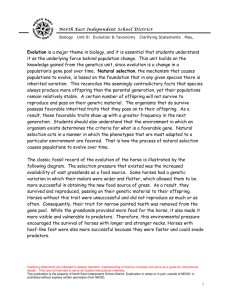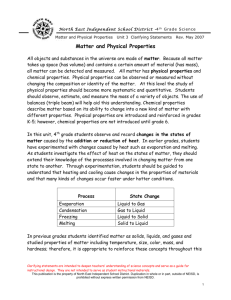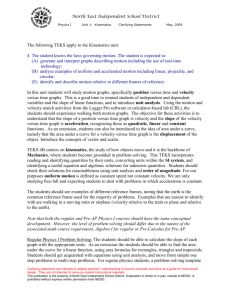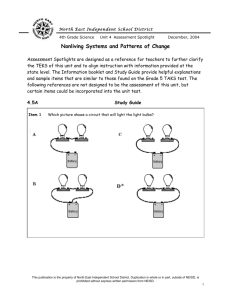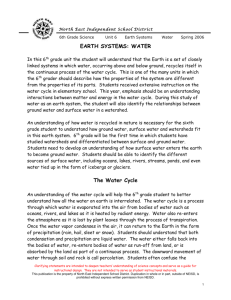Solutions - North East Independent School District
advertisement
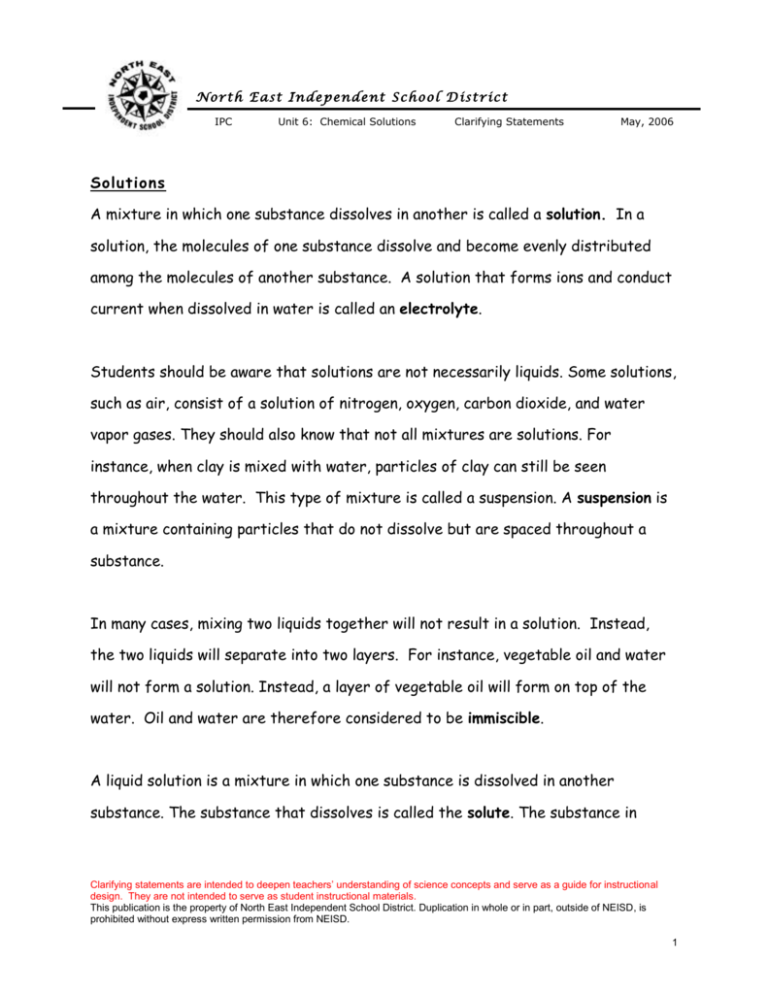
N o r t h E a st I n d e p en d e nt S c h o o l D i st ric t IPC Unit 6: Chemical Solutions Clarifying Statements May, 2006 Solutions A mixture in which one substance dissolves in another is called a solution. In a solution, the molecules of one substance dissolve and become evenly distributed among the molecules of another substance. A solution that forms ions and conduct current when dissolved in water is called an electrolyte. Students should be aware that solutions are not necessarily liquids. Some solutions, such as air, consist of a solution of nitrogen, oxygen, carbon dioxide, and water vapor gases. They should also know that not all mixtures are solutions. For instance, when clay is mixed with water, particles of clay can still be seen throughout the water. This type of mixture is called a suspension. A suspension is a mixture containing particles that do not dissolve but are spaced throughout a substance. In many cases, mixing two liquids together will not result in a solution. Instead, the two liquids will separate into two layers. For instance, vegetable oil and water will not form a solution. Instead, a layer of vegetable oil will form on top of the water. Oil and water are therefore considered to be immiscible. A liquid solution is a mixture in which one substance is dissolved in another substance. The substance that dissolves is called the solute. The substance in Clarifying statements are intended to deepen teachers’ understanding of science concepts and serve as a guide for instructional design. They are not intended to serve as student instructional materials. This publication is the property of North East Independent School District. Duplication in whole or in part, outside of NEISD, is prohibited without express written permission from NEISD. 1 N o r t h E a st I n d e p en d e nt S c h o o l D i st ric t IPC Unit 6: Chemical Solutions Clarifying Statements May, 2006 which the solute dissolves is called the solvent. When salt dissolves in water, salt is the solute and water is the solvent. By increasing the amount of solute in a volume of solvent, a more concentrated solution can be made. A solution with a large amount of solute is said to be a concentrated solution. A solution with a small amount of solute is said to be a dilute solution. Some solutes will dissolve more readily than others in a particular solvent. For example, at certain temperatures, much more sodium nitrate (NaNO3) will dissolve in water than will table salt, sodium chloride (NaCl). Only a certain amount of solute will dissolve in a particular solvent at a particular temperature. The maximum number of grams of solute that will dissolve in 100 ml of a solvent at a certain temperature is called solubility. When a solution contains the most solute it can hold at a given temperature, that solution is said to be a saturated solution. If more solute is added to a saturated solution at a certain temperature, the extra solute will fall to the bottom of the container and not dissolve. This is due to the fact that the spaces between the molecules of the solvent are already filled with particles of solute. There is no room for more solute in the spaces. Clarifying statements are intended to deepen teachers’ understanding of science concepts and serve as a guide for instructional design. They are not intended to serve as student instructional materials. This publication is the property of North East Independent School District. Duplication in whole or in part, outside of NEISD, is prohibited without express written permission from NEISD. 2 N o r t h E a st I n d e p en d e nt S c h o o l D i st ric t IPC Unit 6: Chemical Solutions Clarifying Statements May, 2006 If a saturated solution is heated however, the solution becomes unsaturated. If more solute is then added to this solution, some of the solute will dissolve. This is due to the fact that heating the solvent increases the size of the spaces between the molecules of solvent. The added space creates room for more particles of solute. More solute can then be added to an unsaturated solution until the solution is one again saturated. If the solution is then slowly cooled, the extra solute will remain in solution. The solution will contain more solute than a saturated solution of the same volume. The solution is said to be a supersaturated solution. If a crystal of solute is added to a supersaturated solution, more crystals form in the solution. The above chart has appeared on every TAKS test thus far, so it is important that students be able to read it. They should also understand that each line represents a saturated solution, the areas above the curves represent supersaturated solutions, and areas below the curve represent unsaturated solutions. Clarifying statements are intended to deepen teachers’ understanding of science concepts and serve as a guide for instructional design. They are not intended to serve as student instructional materials. This publication is the property of North East Independent School District. Duplication in whole or in part, outside of NEISD, is prohibited without express written permission from NEISD. 3 N o r t h E a st I n d e p en d e nt S c h o o l D i st ric t IPC Unit 6: Chemical Solutions Clarifying Statements May, 2006 Water: The Universal Solvent There are many substances that can dissolve in water. For this reason, water is sometimes called the universal solvent. Students should be aware that the structure of water helps it dissolve charged particles. The oxygen atom on one water molecule is attracted to a hydrogen atom on a neighboring water molecule. These attractions occur because of oppositely charged areas within the molecule. Water is not an ionic compound, but is instead a polar covalent molecule. This is due to the fact that the shared electrons of each water molecule are not evenly spread throughout the molecule. The oxygen atom attracts shared electrons more strongly than the hydrogen atoms in a water molecule. The following figure shows the structure of the water molecule with its partial charges. Clarifying statements are intended to deepen teachers’ understanding of science concepts and serve as a guide for instructional design. They are not intended to serve as student instructional materials. This publication is the property of North East Independent School District. Duplication in whole or in part, outside of NEISD, is prohibited without express written permission from NEISD. 4 N o r t h E a st I n d e p en d e nt S c h o o l D i st ric t IPC Unit 6: Chemical Solutions Clarifying Statements May, 2006 Sodium chloride dissolves easily in water because the positive sodium ions are attracted to the partially negative oxygen atom, and the negative chloride ions are attracted to the partially positive hydrogen atoms. Students should realize that water can dissolve many substances (especially ionic compounds), but there are many others it can’t dissolve (such as nonpolar covalent molecules). Clarifying statements are intended to deepen teachers’ understanding of science concepts and serve as a guide for instructional design. They are not intended to serve as student instructional materials. This publication is the property of North East Independent School District. Duplication in whole or in part, outside of NEISD, is prohibited without express written permission from NEISD. 5 N o r t h E a st I n d e p en d e nt S c h o o l D i st ric t IPC Unit 6: Chemical Solutions Clarifying Statements May, 2006 Factors that Affect Solubility Students should be familiar with the factors that affect the solubility of a solution such as the following: 1. Solutes with a larger surface area dissolve faster. When a solid is whole, most of its molecules are located deep inside the piece. Breaking the solid open uncovers molecules along the break. The broken solid has more surface area, which leads to more solute-solvent collisions. Therefore, the solid dissolves faster. 2. Stirring or shaking a solution helps the solute dissolve faster as it allows for more collisions between the solute and the solvent. 3. Increasing the temperature changes the dissolving rate because as a substance is heated, its particles move faster. As a result, there are more collisions between particles. The opposite phenomena occur for gases. As temperature increases, gases become less soluble. (An example is soda water). 4. The higher the concentration of reactants, the greater the chance that molecules will collide and speed up the rate of the reaction. If the concentration is lower, there will be fewer collisions and the reaction will proceed at a lower rate. Clarifying statements are intended to deepen teachers’ understanding of science concepts and serve as a guide for instructional design. They are not intended to serve as student instructional materials. This publication is the property of North East Independent School District. Duplication in whole or in part, outside of NEISD, is prohibited without express written permission from NEISD. 6 N o r t h E a st I n d e p en d e nt S c h o o l D i st ric t IPC Unit 6: Chemical Solutions Clarifying Statements May, 2006 5. Pressure affects the rate of solubility, particularly with solutions consisting of gases. When the pressure is increased the molecules have less space in which they can move and thus are more concentrated. That greater concentration of molecules increases the number of collisions. When pressure is decreased molecules don't collide as often and the rate of reaction decreases. 6. The more similar the solute and solvent are in terms of polarity, the greater the solubility of the solution. Polar covalent solvents dissolve polar covalent solutes more effectively than nonpolar solutes. This relationship has been described as “like dissolves like” Acids and Bases An acid is a substance that donates hydrogen ions (H+) to form hydronium ions (H3O) when dissolved in water. A base is a substance that either contains hydroxide ions (OH-) or reacts with water to form hydroxide ions. Indicators are substances that change color depending on whether a solution is acidic, basic, or neutral. The pH of a solution is a measure of its concentration of hydrogen ions. Neutral solutions have a pH of 7, acidic solutions have a pH of less than 7, and basic solutions have a pH of greater than 7. Students must be familiar with the following characteristics of acids, bases and neutrals: Clarifying statements are intended to deepen teachers’ understanding of science concepts and serve as a guide for instructional design. They are not intended to serve as student instructional materials. This publication is the property of North East Independent School District. Duplication in whole or in part, outside of NEISD, is prohibited without express written permission from NEISD. 7 N o r t h E a st I n d e p en d e nt S c h o o l D i st ric t IPC Unit 6: Chemical Solutions Clarifying Statements May, 2006 Characteristics of Acids, Bases and Neutrals Properties pH Tastes sour, corrosive, electrolyte, donates H+ Acid ions to form hydronium Less than 7 ions, turns blue litmus paper red Tastes bitter, feel slippery, corrosive, Base electrolyte, for OH- More than 7 ions, turns red litmus paper blue Contain equal numbers of H+ and OH- ions, Neutral 7 does not change the color of an indicator Clarifying statements are intended to deepen teachers’ understanding of science concepts and serve as a guide for instructional design. They are not intended to serve as student instructional materials. This publication is the property of North East Independent School District. Duplication in whole or in part, outside of NEISD, is prohibited without express written permission from NEISD. 8 N o r t h E a st I n d e p en d e nt S c h o o l D i st ric t IPC Unit 6: Chemical Solutions Clarifying Statements May, 2006 Clarifying statements are intended to deepen teachers’ understanding of science concepts and serve as a guide for instructional design. They are not intended to serve as student instructional materials. This publication is the property of North East Independent School District. Duplication in whole or in part, outside of NEISD, is prohibited without express written permission from NEISD. 9 N o r t h E a st I n d e p en d e nt S c h o o l D i st ric t IPC Unit 6: Chemical Solutions Clarifying Statements May, 2006 Acids and Bases in the Home Students should have a general awareness of the properties of acids and bases commonly found in the home such as the following: Common acids: Strong acids - hydrochloric acid (muriatic acid) used in cleaning and food processing; sulfuric acid inside car batteries; stomach acid Weak acids – acetic acid (vinegar) used in making pickles; citric acid used in preparing flavorings, candies and soft drinks; black coffee, aspirin (acetylsalicylic acid), ascorbic acid (vitamin C) Common bases: Strong bases – potassium hydroxide (potash) used in manufacturing soap and some drain cleaners; calcium hydroxide (lime) used in making plaster, cement and mortar Weak bases - ammonia used in manufacturing fertilizers and many cleaners; baking soda, antacids, hand soap Clarifying statements are intended to deepen teachers’ understanding of science concepts and serve as a guide for instructional design. They are not intended to serve as student instructional materials. This publication is the property of North East Independent School District. Duplication in whole or in part, outside of NEISD, is prohibited without express written permission from NEISD. 10 N o r t h E a st I n d e p en d e nt S c h o o l D i st ric t IPC Unit 6: Chemical Solutions Clarifying Statements May, 2006 Acid rain Acid Rain is the word used to describe rainfall that has a pH level of less than 5.6. This form of air pollution is currently a subject of great controversy because of its worldwide environmental damages. This acidic precipitation can be carried far from their origin, damaging environments along the way. Students should be familiar with the basic fact about acid rain such as the following. The two primary sources of acid rain are sulfur dioxide (SO2), and oxides of nitrogen (NOx). Sulfur dioxide is a colorless gas released as a by-product of combusted fossil fuels containing sulfur. A variety of industrial processes such as the production of iron and steel, utility factories, and crude oil processing produce this gas. Sulfur dioxide can also be emitted into the atmosphere by natural means or disasters such as volcanoes, sea spray, plankton, and rotting vegetation. Overall, 69.4 percent of sulfur dioxide is produced by industrial combustion and only 3.7 percent is caused by transportation. The repairs on building and monuments can be quite costly. In 1990, the United States spent thirty-five billion dollars on paint damage alone. One of the serious side effects of acid rain is that the sulfur dioxide and nitrogen oxide emission cause respiratory problems such as dry coughs, asthma, headaches, eye, nose, and throat irritation. Clarifying statements are intended to deepen teachers’ understanding of science concepts and serve as a guide for instructional design. They are not intended to serve as student instructional materials. This publication is the property of North East Independent School District. Duplication in whole or in part, outside of NEISD, is prohibited without express written permission from NEISD. 11
